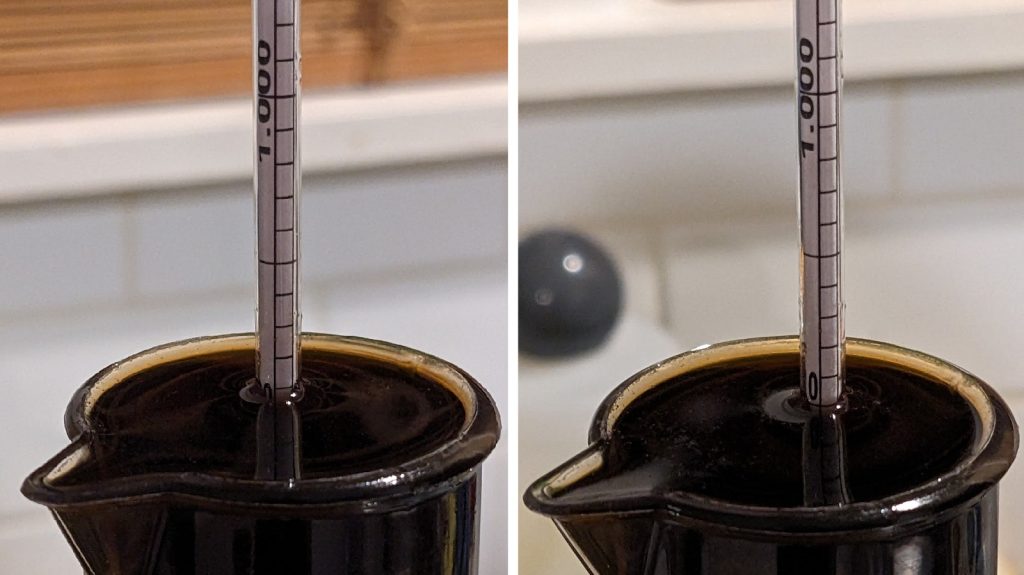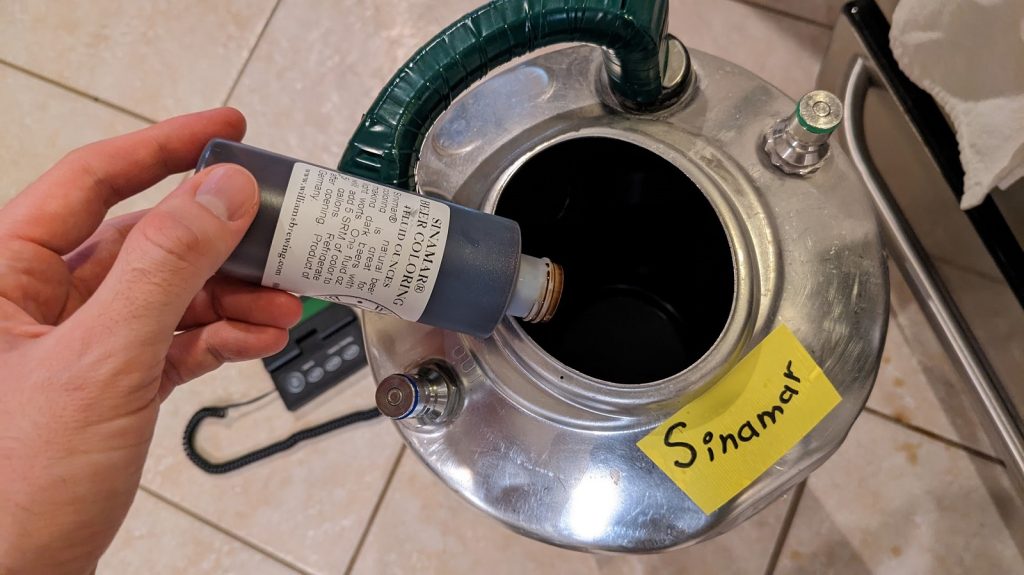Author: Alex Shanks-Abel
It’s often said that we eat with our eyes first, an idiomatic expression used to convey the idea that our expectations are influenced by what we see. This trope unquestionably applies to beer, which comes in a wide-range of colors and clarity. Serve someone a crystal clear, fizzy, yellow pint and they’ll more than likely expect something crisp and refreshing, whereas being served a glass full of black, opaque liquid will elicit expectations of coffee and chocolate.
These days, there exists a vast array of beer styles, the colors of which are largely a function of the ingredients used to make them. However, beers of the same color don’t necessarily share the same organoleptic characteristics. An example is Stout, which has notable roast flavors, and Schwarzbier, which can be equally as dark but with minimal roast characteristics. To achieve this, brewers often use debittered roasted grains, though another options Sinamar, a natural colorant made from Carafa Special II malt that’s widely believed to impact only beer color.
I’ve never focused much on Sinamar or other beer colorants specifically because of the claim that it’s used solely to adjust appearance, as I’ve never had a big issue with the way my beers look. I love dark lagers and have brewed numerous batches over the years using a variety of roasted grains, occasionally ending up with a beer that was a tad lighter than expected while tasting great. Curious of the impact Sinamar has on an already dark beer, I designed an xBmt to test it out!
| PURPOSE |
To evaluate the differences between a Schwarzbier dosed with Sinamar and one that was not dosed.
| METHODS |
For this xBmt, I went with a simple Schwarzbier recipe I’ve been happy with in the past.
Ain’t Abel’s Arnold
Recipe Details
| Batch Size | Boil Time | IBU | SRM | Est. OG | Est. FG | ABV |
|---|---|---|---|---|---|---|
| 5 gal | 60 min | 16.2 | 35.6 SRM | 1.047 | 1.009 | 4.99 % |
| Actuals | 1.047 | 1.009 | 4.99 % | |||
Fermentables
| Name | Amount | % |
|---|---|---|
| Pilsner Malt | 6 lbs | 77.42 |
| Metolius: Munich-style Barley Malt | 1 lbs | 12.9 |
| Black (Patent) Malt | 8 oz | 6.45 |
| Sinamar | 4 oz | 3.23 |
Hops
| Name | Amount | Time | Use | Form | Alpha % |
|---|---|---|---|---|---|
| Hallertauer Hersbrucker | 75 g | 60 min | First Wort | Pellet | 1.4 |
Yeast
| Name | Lab | Attenuation | Temperature |
|---|---|---|---|
| Kaiser (G02) | Imperial Yeast | 77% | 55.9°F - 64.9°F |
Notes
| Water Profile: Ca 30 | Mg 0 | Na 0 | SO4 35 | Cl 27 |
Download
| Download this recipe's BeerXML file |
I started my brew day by the full volume of water for a single 10 gallon/38 liter batch, adjusting it to my desired profile, and getting it heating up before weighing out and milling the grain.
Once the water was adequately heated, I incorporated the grains then checked to make sure it was at my target mash temperature.
While the mash was resting, I prepared the single kettle hop addition.
Once each 60 minute mash was complete, I removed the grains then boiled the wort for 60 minutes before chilling it, at which point I evenly split it between two fermentation kegs.
At this point, I added 4 oz/118 mL of Sinamar to one of the worts.
Refractometer readings taken after the Sinamar addition showed it had no real impact on OG.

The filled fermenters were placed in my chamber and left to finish chilling to my desired fermentation temperature of 59°F/15°C for a few hours before I pitched a pouch of Imperial Yeast G02 Kaiser into each.
After 2 weeks of fermentation, I took hydrometer measurements showing a very small difference in FG.

At this point, I transferred the beers to sanitized serving kegs and allowed them to condition on gas for a couple more weeks before they were ready to serve to tasters.

| RESULTS |
Huge thanks to Yakima Valley Hops for allowing me to hunker down at their booth to collect data during the 2023 Homebrew Con in San Diego, CA! A total of 31 people of varying levels of experience participated in this xBmt. Each participant was served 2 samples of the beer dosed with Sinamar and 1 sample of the standard Schwarzbier in different colored opaque cups then asked to identify the unique sample. While 16 tasters (p<0.05) would have had to accurately identify the unique sample in order to reach statistical significance, just 14 did (p=0.12), indicating participants in this xBmt were unable to reliably distinguish a Schwarzbier dosed with 4 oz/118 mL of Sinamar from one that was not dosed.
My Impressions: Out of the 5 semi-blind triangle tests I attempted, I correctly identified the odd-beer-out twice. Despite the fairly obviously color difference, these beers smelled and tasted identical to me, both sharing a crisp, clean flavor with a hint of coffee in the finish. This beer was delicious and paired particularly well with Mexican food!
| DISCUSSION |
In the centuries that people have been making beer, there have been many advancements to assist brewers with crafting exactly what it is they’re after. While for some, beer color comes second to the way it tastes, others view it as a part of the whole experience, and one product created to help achieve ideal color is Sinamar. Corroborating the claims of many, tasters in this xBmt were unable to reliably distinguish a Schwarzbier dosed with 4 oz/118 mL of Sinamar from one that was not dosed.
The most obvious explanation for this result is that, as marketed, Sinamar has a marked impact on beer color without affecting other characteristics. However, it’s also possible the use of Black Patent malt overwhelmed the flavor imparted by the Sinamar, though this contradicts findings from a past xBmt comparing Kölsch made with and without this product.
These results will likely have little influence on my own brewing since I tend to be happy with the color of my beer, but for those who are concerned about appearance, I think it’s safe to expect Sinamar to have little if any impact on beer aroma, flavor, or mouthfeel. At least when used at the recommended dosage rate.
If you have any thoughts about this xBmt, please do not hesitate to share in the comments section below!
Support Brülosophy In Style!
All designs are available in various colors and sizes on Amazon!
Follow Brülosophy on:
FACEBOOK | TWITTER | INSTAGRAM
If you enjoy this stuff and feel compelled to support Brulosophy.com, please check out the Support page for details on how you can very easily do so. Thanks!



















4 thoughts on “exBEERiment | Impact Sinamar Has On A Schwarzbier”
I love the color on the no Sinimar batch. Really nice ruby red going on there. Also what do you cover those handles with on your kegs besides tape. I have a bunch of that style and I don’t like the handles.
Thanks, it looks great in-person, too! I’m afraid I did use tape! I wrapped them in multiple layers of colored electrical tape because yeah, the handles are pretty flimsy and ugly. The electrical tape makes them look prettier and provides a much better grip.
I quite like the color of the no Sinamar beer myself… I can’t imagine treating such a beer with such a lovely color. Interesting experiment though! I am wondering the impact on other styles. I’d love to know if this would be a good idea for an upcoming Cascadian Dark Ale that I am planning.
I have to agree that the no-Sinamar easily wins because of appearance! Nice, I imagine Sinamar would be perfect for a Cascadian Dark Ale! Even if it does change the flavor, a little hint of roast would not be out of style.